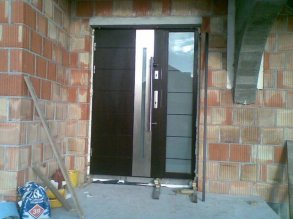Add interest to your entryway with a front door that works well, fits your home and is energy efficient.
Entry doors come in wood, metal and fiberglass. The larger the door and more elaborate the design, the more it will cost.
Good Wood
Wood doors are naturally warm and inviting. Best used in a covered area such as a house with a portico or porch, or in combination with a storm door that will protect it from the elements, a wood door will last for many years with minimal maintenance of painting and staining.
Door makers have stepped up their offerings with thicker panels, better weather stripping and energy-efficient glass inserts in a wide variety of designs to suit any decor. Woods include oak, mahogany, maple, teak, black locust, fir and pine.
The enemy of a wood door is moisture that causes rot. Water from rain can seep into joints, loosening them and allowing air to enter or exit, making them less energy efficient. Look for doors that combat this problem with proper water-barrier construction that allows rain to run off the door without entering joints.
Wood doors scratch, peel, bubble and warp if not protected. Off-the-shelf replacement doors are the least expensive, while custom wood doors are the most costly. Wood doors are usually the most expensive option for an entry.
What's the Appeal of Steel?
Steel entry doors are made of a wood frame that holds insulation to make them energy efficient. Doors, including the frame, are clad in epoxy-coated galvanized steel. The steel has a baked enamel finish that can be painted in the color of your choice. The energy-efficient core helps lower heating and cooling costs.
Steel doors are available in any style, from traditional to contemporary. A high-quality steel door can last a lifetime with little maintenance and they will not warp like wood doors.
The downside? They can dent, paint can chip, and un-repaired scratches can lead to rust. Yet they are the most secure. Prices vary, but they are typically less expensive than wood doors.
The Scoop on Fiberglass
Fiberglass is the latest in front door options. They are made of composite materials clad in a fiberglass panel, with a grainy pattern to resemble wood. They also come in smooth finishes that can be painted or stained in your choice of color.
They have an energy-efficient core to help lower heating and cooling costs and are low maintenance as they don't rot, rust, warp or deteriorate over time.
Fiberglass can scratch and dent but generally less than wood or steel doors. Prices vary depending on the size and options you want, such as glass inserts and finishes. Fiberglass doors in standard sizes will help keep costs down, but custom versions will cost more.












A standard 3'0" x 6'8" steel front door weighs about 75 lbs.